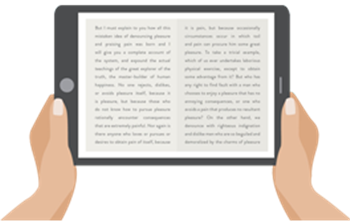(单词翻译:单击)

Measured against how long we have been around, humans began reading only recently. The earliest scripts emerged about 5,000 years ago.
以人类存在的整个历史衡量,人类只是在最近才开始阅读。最早的手稿出现在大约5000年前。
The Greeks produced a fully-developed alphabet, with vowels, about 3,000 years ago. Johannes Gutenberg printed his bible 560 years ago.
希腊人在大约3000年前发明了带有元音的、成熟的字母表。约翰内斯•谷登堡(Johannes Gutenberg)于560年前印刷出了圣经。
If reading from the printed page is recent, then reading from a digital screen is a just-peeled-the-protective-plastic-off novelty.
如果说人类只是从最近才开始阅读印刷文字的话,那么从数字屏幕上阅读就如刚刚撕掉塑料保护膜一样的新鲜。
Many have described the advent of digital reading as the biggest revolution since Gutenberg. We are still not sure what digital screens are doing to the process of reading. While researchers have tried to examine the difference between print and onscreen reading, the results are fuzzy.
很多人把数字化阅读的出现描述为自谷登堡以来的最大变革。我们尚无法确定数字化屏幕对阅读过程具有何种影响。尽管研究人员尝试了研究纸质阅读和屏幕阅读的区别,但结果并不清晰。
Some studies have found little difference in comprehension and recall between those reading print and those looking at screens. Others have found lower understanding and memory among screen readers.
一些研究发现,纸质阅读和屏幕阅读在理解和回忆方面几乎没有区别。另外一些研究发现,屏幕阅读者在理解和记忆方面表现较差。
Apart from the difficulties of assessing how people absorb meaning, digital devices are still changing and developing, attempting to make the reading process smoother.
除了在评估人们如何吸收语意上存在困难外,数字化设备仍在不断变化和发展,试图让阅读过程更加顺畅。
As reading researchers Anne Mangen of the University of Stavanger and Don Kuiken of the University of Alberta admit, it is best to see their and others’ studies as “an exploration of possibilities rather than explicit hypothesis testing”.
正如阅读研究员、挪威斯塔万格大学(University of Stavanger)的安妮•芒让(Anne Mangen)和加拿大阿尔伯塔大学(University of Alberta)的唐•奎肯(Don Kuiken)所承认的那样,最好把他们和其他人的研究看作是“一次关于可能性的探索,而非明确的假设检验”。
Their research examined whether people read differently on a screen (the Kindle app on an iPad) and a printed page, but also looked at the difference between fiction and non-fiction. They gave their subjects a piece of writing describing an actual murder at a mall, and told one group it was made-up and the other that it was real.
他们对人们在屏幕(iPad上的Kindle应用软件)和纸质阅读是否存在差异进行研究,不过也观察了阅读小说和非小说之间的差异。他们给了研究对象一篇讲述一宗发生在商场的真实谋杀案的文章,告诉其中一组这件事是虚构的,告诉另一组文章是真实的。
Among those who thought it was fiction, there was little difference between screen and print readers. Those reading from the iPad were a little unsure of their location in the text. But their grasp of the narrative, their immersion in the story and how much sympathy they felt with the characters differed little from that of the print readers.
在认为阅读内容为小说的研究对象中,屏幕阅读和纸质阅读之间几乎没有差别。在iPad上阅读的人对文中所述事件的发生地点有点不确定。但是他们对文字叙述的理解、对故事情节的投入以及对人物的同情程度,与纸质阅读者几乎没有差别。
Among those who thought they were reading non-fiction, there was a significant difference. The iPad readers had less narrative grasp, less immersion and less sympathy.
那组认为自己阅读的是非小说的研究对象,则存在显著差别。与纸质阅读者相比,iPad阅读者对文字叙述的理解更差,对故事的投入更弱,同情心也更少。
Why the difference? The writers quote research suggesting that reading non-fiction involves fast processing (“skimming”)” while fiction involves slow processing (“savouring”).
为什么会存在差异?两位作者引用研究称,阅读非小说涉及快速处理(“略读”),而阅读小说涉及慢速处理(“品味”)。
The suggestion is that reading screens for factual information encourages skimming so that when the narrative is more detailed it becomes less comprehensible.
这似乎表明,在屏幕上阅读事实类信息促使阅读者进行略读,因此当文字叙述比较详细时,理解就较差。
This matches my experience. I am reading 10 novels, as chairman of the judges of theFinancial Times arts awards for emerging market countries. As I have been travelling, I have mostly been reading on a Kindle.
这与我的经验相符。作为英国《金融时报》评判新兴市场国家艺术奖的主席,我目前正在阅读10本小说。由于我最近在出差,我大多时候都用Kindle看书。
I prefer real books, for the heft, the ease of paging back and the sense of how far I have read — which I can see and feel, rather than relying on a percentage at the bottom of the page. But a Kindle is compact and easy on the eyes and, like the students in the study, I have had no problem immersing myself in the stories.
我更喜欢实实在在的书,因为它有重量,能轻易翻回之前的页,也能直观感受到自己已经读了多少——这是我“看得见摸得着”的,而不需要依靠屏幕下方的进度条来判断。但是,Kindle外形小巧紧凑,阅读起来不伤眼睛,而且就像上述研究的参加者那样,我可以让自己投入故事情节。
Reading news is different. When my morning train is crowded, I read from an iPhone app rather than a newspaper. When I get into the office and page through the FT, I find I have read most of it — but not all.
阅读新闻则有所不同。当上班的列车很拥挤时,我用iPhone上的一款app看新闻,而不是直接看报纸。当我进入办公室浏览英国《金融时报》时,我发现自己看过了大部分内容——但并非全部。
When I use an app, I read what I am interested in. When I read a print newspaper, I find myself reading things I did not know I was interested in.
当我使用app时,我只看自己感兴趣的内容。但我看纸质报纸时,我会看一些之前不知道自己会感兴趣的内容。
Others have spoken about the serendipity of print, but I think there is more to it. Reading from a mobile phone, the fastest-growing form of digital reading, is useful, but it is, literally, narrower than print.
有人曾谈到纸质阅读的意外收获,但我认为没这么简单。作为增长最快的数字化阅读方式,手机阅读很有用,但是它显然比纸质阅读更“窄”。
A newspaper offers peripheral vision. There is the likelihood not only that you will come across unexpected information, but that you will connect it to other things you have read.
报纸提供周边视觉。你不仅可能看到意想不到的信息,还可能会把它与你读过的内容联系起来。
This is important for those whose job is to think about the threats, opportunities and changes that might affect the business. It is not an either/or. You have to be immersed in the digital world too to know what it is doing to people’s behaviour.
对于职责就是思索可能影响业务的威胁、机会和变化的人来说,这很重要。这并非是个非此即彼的选择。你也必须沉浸到数字化世界中,才能了解它对人们的行为产生了什么影响。
Studies in the US show that those who still read a newspaper are higher-earning and better-educated.
美国的研究表明,如今仍然阅读报纸的人的收入更高、受教育水平也更高。
They are also generally older. But every now and then I meet a 20-something digital native who reads print newspapers, too. I immediately assume they have a great future.
他们也普遍年纪更大。但是我也会不时地遇到一个20多岁的“数字化原住民”在阅读纸质报纸。我会立马认为他们拥有一个光明的前途。


